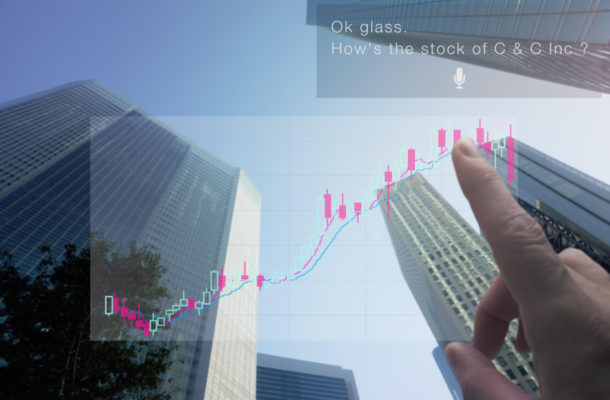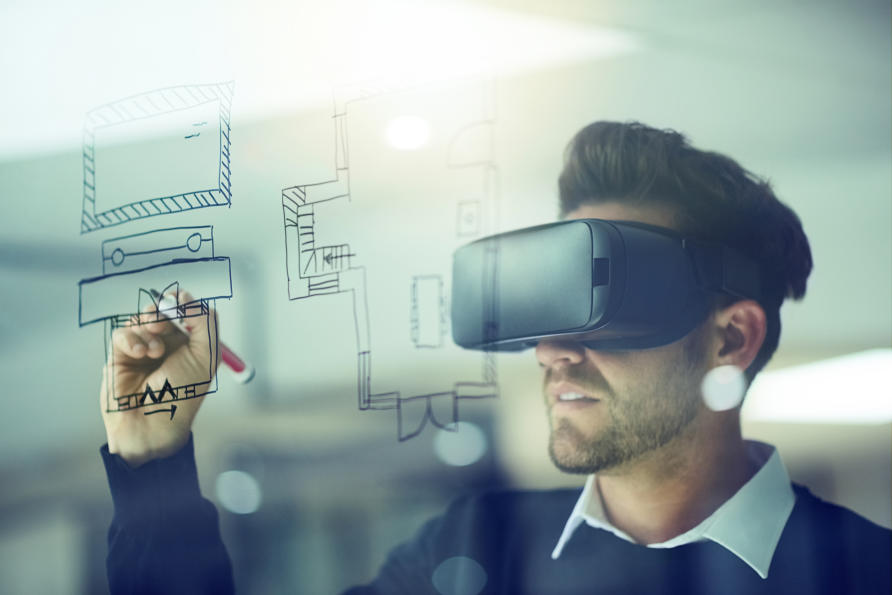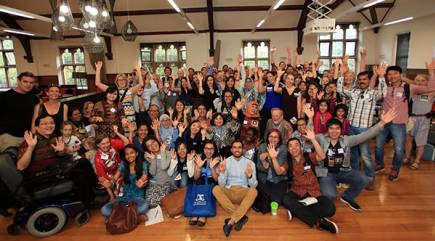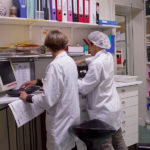The new hyper-reality of work

Chances are you are reading this article on some sort of screen – a computer, a tablet, or a phone. But imagine a future where there are no screens, no phone handsets or keyboards, and the only mouse is in the office kitchen cupboards.
This is the office of the future, where Augmented Reality (AR) and Virtual Reality (VR) change our working lives. AR overlays digital information on the real world, while VR creates an immersive, simulated environment that replaces the real world.
Here, office workers wear Augmented Reality (AR) glasses to interact with a digital overlay of controls projected onto any surface, allowing them to make calls, dictate emails, and operate software simply by moving their hands, arms, legs and even their eyes to command an action. Others wear Virtual Reality (VR) headsets to spatially collaborate on 3D tasks – collaborating with colleagues down the road or on the other side of the world.
Working with smart glasses
Out in the field, workers also wear AR glasses that give them instant access to technical information and instructions as they work on a building site or liaise with customers. They also use VR headsets in their autonomous cars, working on designs and fixes with colleagues offsite.
“The endgame will depend on how technology progresses and becomes faster and smaller, and headsets become lighter to wear and easier to use,” says University of Melbourne communications and media production consultant Ben Loveridge.
“But I think given the way it is heading, we can imagine a work place where people will routinely wear smart glasses or perhaps even smart contact lens that can provide a mix of AR and VR.”
As Mr Loveridge talks to me, he is wearing a VR headset and waving his arms around in a painting motion. On the computer screen above, I see he is creating a three-dimensional sculpture in Tiltbrush, which he then walks around to get a better look at his handiwork. It isn’t hard to imagine that designers and engineers could soon be routinely working together in 3D as they co-create and problem-solve using VR.
“Eventually we might be able to easily and accurately track hands and people’s whole bodies without controls,’’ he say. “Then there is the question of whether we can introduce a sense of touch into VR to give people a feeling of pushing against an object. That may mean wearing special gloves or a whole suit. We may eventually be able to simply use eye tracking to govern controls and applications. These are all areas that people are working on.”

Internationally, businesses are already exploring how the technology can benefit the bottom line. Singapore’s Changi Airport is aiming to speed up cargo loading using AR. Ground handlers will use the glasses to read visual cues attached to different cargoes that then links instantly to loading instructions.
AR researcher Dr Thuong Hoang, at the University of Melbourne’s Microsoft Research Centre for Social Natural User Interfaces, says people are only now just starting to realise the huge potential of AR and VR in the workplace.
Augmenting training
“Initially, most people in this area were focused on the technology behind AR and VR rather than what we can do with it, but that is gradually changing and now people are actively looking for opportunities to apply it,” says Dr Hoang.
Inspired by gaming technology, Dr Hoang has used AR to enhance physiotherapy teaching by projecting images of muscles and skeleton over a live model. It provides students with a clear, visual understanding of the inner workings of our bodies.
“The gamification of training introduces a new element of excitement and motivation into learning that can otherwise be missing,” says Dr Hoang.
AR and VR is continuing to gain traction in the area of training and education.
Dr Hoang notes that US fast-food giant KFC has created a tongue-in-cheek VR gaming experience to introduce new staff to the basics of cooking chicken.
“Starting a new job is already stressful enough, but if an employer can provide some training using VR or AR before a new employee starts I can see it making that first day at work a lot less stressful,” says Dr Hoang.
Virtual field trips
University of Melbourne classics scholar Dr Monique Webber is creating teaching videos, edited by the eTeaching Unit in the Faculty of Arts, that use VR to present ancient artworks as 3D objects. Dr Webber can then walk around the object, annotating and highlighting important features to the students. These annotations teach students the analytical process they will use in the University’s Object-Based Learning Lab where they handle artefacts from the University of Melbourne’s own collection.
“It is a blended learning approach between VR and reality that trains students in the tasks they will use both at University and in the field,” says Dr Webber, from the School of Historical and Philosophical Studies.
She says experiencing the artworks in VR during the making of the videos has sometimes meant she has formed a whole new appreciation of a work.
“I’ve seen these objects in the ‘flesh’ in Europe but by being able to actually get close to them in the VR, I was able to see completely new relations between form, depth and composition,” says Dr Webber.
The ideal, she says, will be when the technology becomes affordable enough to allow thousands of students to easily access VR. “For the students, it would mean they could all have an experience that previously they would only get by travelling to Rome.”
And more affordable access to high-quality VR may only be a few years away, according to Mr Loveridge. At the moment, a VR headset that allows movement in three dimensions, with hand controllers costs at least $1,500 – but smart-phone giants and other tech companies are already moving to make the market more competitive. For Dr Webber, this new reality is already revolutionising teaching.
“The technology is completely changing the field. Previously teachers developed teaching materials. Now, we are hunting for opportunities that enhance hands-on learning experiences through the medium of VR.”
This piece was written by Ben Loveridge, Dr Monique Webber and Dr Thuong Hoang . This article was first published on Pursuit. Read the original article.
Dr Monique Webber is an Honorary Fellow in Classics and Archaeology at the School of Historical and Philosophical Studies at the University of Melbourne.









